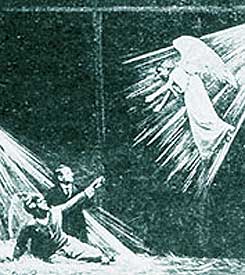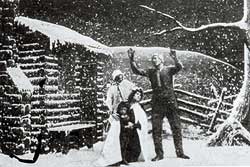 Uncle Tom's Cabin; or, Slavery Days (1903) opens with the titular cabin surrounded by wintery snows, an aesthetic set of real visual charm. Uncle Tom's Cabin; or, Slavery Days (1903) opens with the titular cabin surrounded by wintery snows, an aesthetic set of real visual charm.
Eliza Harris & her child tap on the window & Aunt Cloe & Uncle Tom come to the door, learning that Eliza's son have been sold to Shelby the slave trader. Rather than be separated from her child she intends to run away.
The next set is the interior of a tavern with a potbellied stove, a bar, a table, two stools, simple but once again elegant in its rusticity. Phenias enters stage right with Eliza & her son.
Phenias though a plantation owner is on the side of liberating the slaves (he's in love with a Quaker maiden after all) & instructs Eliza on getting across the river. When men arrive at the tavern searching for the slaves, Phenias holds them at gun-point while Eliza & the boy can escape.
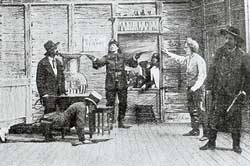 The set changes to a wonderfully clever river scene, with ice flow in motion. Eliza with her child leaps onto a chunk of ice & is taken away by the river's flow, while the three slave hunters struggle on the riverbank. The set changes to a wonderfully clever river scene, with ice flow in motion. Eliza with her child leaps onto a chunk of ice & is taken away by the river's flow, while the three slave hunters struggle on the riverbank.
Though the "escape on the ice flow" became a cliche of silent cinema most strongly associated with D. W. Griffith, Porter is the first to exploit such imagery on screen.
Ruth's Quaker home provides the next setting, with a treddle spinning-wheel just outside the door, & moss heavy on the roof. Here Eliza & her son are reunited with George, her husband & the boy's father. Phenias shows them to a place to hide, with another escape scene soon to follow, & one of the slavers shot by Phenias.
The sequence on the Mississippi River shows a race between the steamboats, done with the cutest damned miniatures. The shimmering water beneath the boats & the lightning FX are cuter than they are thrilling for today's audience, but it's easy to detect how purely thrilling it would've been early in the very early 1900s.
The steamboat Robert E. Lee arrives at its dock, where negroes are dancing an excited greeting. Uncle Tom is on board, being transported to New Orleans where he's to be sold. In the crowd of passengers, a white child, Little Eva, is knocked into the Mississippi. Old Tom leaps in the water to rescue her.
Little Eva's father Augustine St Clair is impressed by Tom's heroic act. Right then & there he buys Tom for his own family.
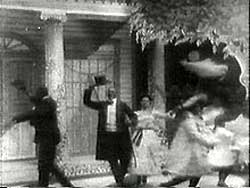 The set changes to the plantation home of Little Eva's family, nice people who have given Tom happiness, making him their house slave. Included is a comedy sequence of the Dance of Topsy, not a child in this adaptation, but a grown young slave woman, hence apparently retarded, & treated like a child when yelled at for taking a piece of ribbon. The set changes to the plantation home of Little Eva's family, nice people who have given Tom happiness, making him their house slave. Included is a comedy sequence of the Dance of Topsy, not a child in this adaptation, but a grown young slave woman, hence apparently retarded, & treated like a child when yelled at for taking a piece of ribbon.
The sentimental joy of being a child with one's very own grampa-slave is acted out in the garden with a long comical dancin'g squence followed by Tom & Little Eva further bonding before Tom carries the worn out Eva off to bed. The tragedy of slavery is momentarily shunted aside with the promise of a happy slave life with the St Clairs.
The issue of slavery is further upstaged by the tragedy of Eva's illness. Porter's film has a cool FX scene at this point when a transluscent angel descends to Eva's deathbed & takes up her soul.
Augustine goes into an alcoholic funk over the loss of his daughter. The evil acts of Simon Legree follow, with St Clair slain for defending Uncle Tom.
In consquence of St Clair's murder, the family's slave holdings will soon be auctioned to highest bidders. In a nasty little scene grafted onto Stowe's story, but nowhere in the book itself, the slaves gathered for sale dance gaily & gamble & are very happy while waiting to be sold.
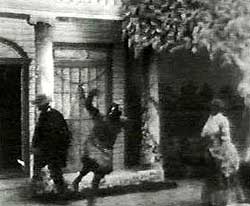 That bit of racist insensitivity originates in white writers who theoretically agreed with Stowe that slavery was bad, but that didn't keep them from embracing the most racist of stereotypes. That bit of racist insensitivity originates in white writers who theoretically agreed with Stowe that slavery was bad, but that didn't keep them from embracing the most racist of stereotypes.
By the time Porter put it in his film, the whole idea of the happy dancing gambling auctioned slaves was already a fifty year old cliche. From our modern perspective it is hard to imagine what was in the mind of whites who believed slaves would dance & gamble while waiting to be sold.
Simon Legree is determined to buy Tom at any price in order to have the right to abuse him. As the new proud owner of old Tom & the beautiful mulatto Emaline, Legree has them in the fields working, when for sheer sadistic pleasure Legree demands that Tom whip Emaline. When he refuses, he is himself flogged horribly.
The beautiful slave Cassy stops the flogging, grabs the whip, & nearly beats Simon Legree with it. She & Emaline thus go into hiding for fear of Legree's vengeance as well as his lusts. When Tom refuses to reveal where the young women are, Legree beats him on the stately veranda. Tom is dragged away, so injured he's dying.
The son of Tom's past owner had never forgotten the old man. Having inherited his father's planation, he has wanted to set some of his father's ill deeds to rights. But he arrives too late to save Uncle Tom.
He's armed with a warrant for Legree's arrest for the murder of St. Clair. When Legree attacks the young man, he draws a gun in self defense, & good-bye Simon Legree.
Tom lies dying in a shed. His would-be savior arrives promising to take him home to the Shelby plantation where he'll never again be mistreated. But Tom dies, & a honky angel appears to take his soul to the heavenly plantation.
The film concludes with an early montage showing the execution of John Brown, the Civil War, & Lincoln (creepily with a slave on his knees clutching Lincoln's legs).
copyright © by Paghat the Ratgirl
|
